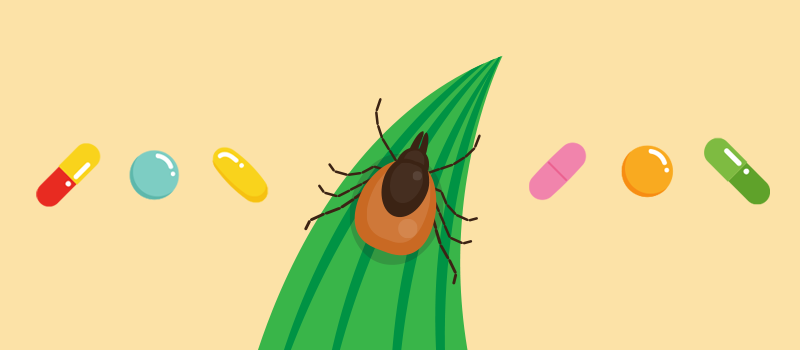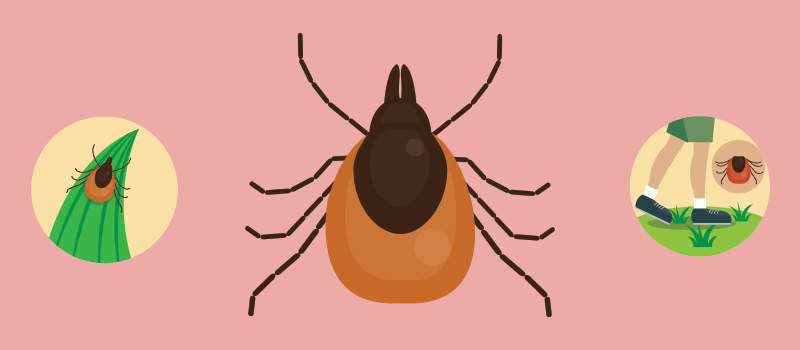What’s the Buzz
The Bee Healthy Blog
Medications to Help Combat Lyme Disease

Lyme disease is a tick-borne bacterial infection caused by bacteria called Borrelia. Four different species of this bacteria are known to cause Lyme disease in humans. Of these, Borrelia mayonii and Borrelia burgdorferi are found in the US. Borrelia garinii and Borrelia afzelii are known causes of Lyme disease in other parts of the world, such as Asia and Europe.
Lyme disease spreads through tick bites, specifically deer ticks or black-legged ticks. People who walk in wooded areas or areas with long grass where ticks thrive are at greater risk of getting Lyme disease. That’s why it’s important to take steps for prevention if you live in such areas. However, if you get infected and develop Lyme disease, it can be treated with medicine.
Please continue reading to learn more about the drugs that are used to treat Lyme disease.
Signs and Symptoms of Early Lyme Disease
A tick bite can leave a tiny, red bump that looks much like a mosquito bite. The presence of this bump does not mean you have Lyme disease. However, if you develop symptoms in the weeks to months after a tick bite, it could mean you have Lyme disease.
Signs and symptoms of Lyme disease include a rash called erythema migrans. This is typically a gradually expanding bull’s eye pattern. This rash begins at the site of the tick bite, then gradually expands over several days, reaching up to 12 inches or more. Keep in mind that this rash can appear anytime between 3 to 30 days.
Other symptoms of early-stage Lyme disease can include fatigue, fever, chills, headache, body ache, swollen lymph nodes, and a stiff neck.
Signs and Symptoms of Chronic Lyme Disease
If Lyme disease is left untreated, it can develop into a chronic infection with persistent symptoms. The lingering symptoms can include a rash (erythema migrans) in other parts of the body and joint pain. Some people develop neurological problems like meningitis, Bell’s palsy (temporary paralysis on the left or right face), numbness, weakness, and problems with muscle movement. Keep in mind that neurological problems can take place weeks, months, or even years after the initial infection.
Less commonly, Lyme disease patients can develop complications such as heart rhythm abnormalities (irregular heartbeat), liver inflammation, eye inflammation, and severe fatigue. These complications can occur several weeks after the infection.
Can medication treat Lyme disease?
Yes, medications can treat Lyme disease. Since it is a bacterial infection, the treatment is antibiotic therapy. Your doctor can choose between various antibiotics.
Standard antibiotics are given orally (by mouth) to treat early Lyme disease. IV antibiotics (intravenous antibiotics) are used if the disease has spread to the central nervous system.
You should know that all tick bites do not lead to Lyme disease or require antibiotics. However, the longer a tick remains on your skin, the higher is your risk of getting Lyme disease. Lyme borreliosis infection is uncommon if the tick is removed from the skin within a day or two.
That’s why if you suspect you have been bitten by a tick and have symptoms of Lyme disease — especially if you live in a tick-infested region — you should contact a healthcare professional without delay. Lyme disease treatment works better, and recovery is faster if the treatment is started early.
What is the strongest antibiotic for Lyme disease?
Three oral antibiotics are used to treat Lyme disease in the United States — amoxicillin (Amoxil), doxycycline (Doryx, Monodox, Oracea, Vibramycin), and cefuroxime (Ceftin, Zinacef). Amoxicillin and cefuroxime can be given to adults, children, pregnant women, and breastfeeding mothers. Doxycycline can be given to adults and children over the age of 8. In the case of beta-lactam allergies (e.g. amoxicillin or cefuroxime) and a concern for neurological disease in pregnant women, doxycycline can be used based on the physician’s judgment.
Oral antibiotics are usually prescribed for 14 to 21 days. However, there is data supporting a 10 to 14-day course of antibiotics.
The intravenous antibiotic ceftriaxone (Rocephin) is the preferred treatment for Lyme disease with neurological involvement. Ceftriaxone penetrates the blood-brain barrier very effectively. Intravenous ceftriaxone is given once a day for 14 to 28 days.
Other treatment options include antibiotics like benzathine penicillin (an intramuscular antibiotic). Antibiotic treatment with macrolide antibiotics (azithromycin and clarithromycin) are considered second-line and may be used in people who cannot tolerate amoxicillin, doxycycline, or cefuroxime.
Extended antibiotic treatment for 14-28 days is recommended to eliminate the infection completely. However, long-term antibiotic use, especially with an intravenous antibiotic, can cause various adverse effects such as diarrhea, reduction in white blood cell count, and increased risk of antibiotic-resistant infection caused by organisms unrelated to Lyme disease. That’s why it’s important to take antibiotics exactly as advised by an infectious disease specialist.
What is the most effective treatment for Lyme disease?
Antibiotics are the only effective and proven treatment for an active infection of Lyme disease. Sometimes, if a person has unexplained symptoms or their symptoms persist, they might think they have Lyme disease even though it’s not been diagnosed by a doctor. Such individuals often turn to unorthodox alternative therapies marketed as effective treatments for Lyme disease. However, there is no scientific evidence that anything other than antibiotics is an effective treatment of Lyme disease. Alternative treatments may be ineffective, or worse, harmful or deadly. Always consult a healthcare professional if you’re considering alternative treatment options for Lyme disease.
A small number of people can have persistent symptoms after Lyme disease has been treated with antibiotics. These symptoms are usually fatigue, muscle aches, with or without a decline in cognitive function. The reason for these continuing symptoms is unknown. Some experts believe they occur because of an autoimmune response after Lyme disease. However, while the cause is unclear, we know that more antibiotics or alternative treatments do not help with lingering symptoms in post-treatment Lyme disease syndrome.
You should know that getting and treating Lyme disease once does not give you immunity in the future, and you can get infected again. To prevent complications, you should always take precautions and get medical care immediately once you notice any symptom of a tick bite.
How can I prevent Lyme disease?
The most effective prevention method is avoiding areas where deer ticks that transmit Lyme disease thrive. You can also reduce your risk by:
- Covering up when walking in wooded areas
- Using insect repellant
- Checking your clothes, yourself, your kids, and your pets for ticks after you’ve been outdoors (deer ticks are the size of a pinhead, so you will need to look carefully)
- Removing any visible ticks carefully with tweezers
- Showering and using a washcloth after you’ve been outdoors
- Sticking to trails while on walks
- Keeping your dog on a leash
- Tick-proofing your yard
- Mowing your lawn regularly
References:


SOCIAL